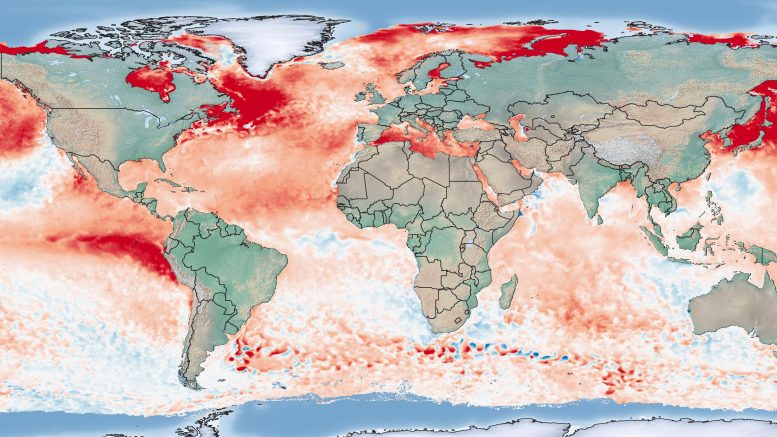
Anomaly of ocean surface temperature on July 31, 2023 (reference period 1985 to 2012; data from NOAA/Coral Reef Watch). Credit: Bernhard Mühr, CEDIM/KIT
The first three weeks of July 2023 have been the hottest global three-week period so far. In the summer months of 2023, twice as many people in Germany were exposed to daily temperatures of 35 °C (95 °F) and higher than the average from 1980 to 1999. This is obvious from a study published recently by Karlsruhe Institute of Technology (KIT). Researchers from KIT’s Center for Disaster Management and Risk Reduction Technology (CEDIM) report that the European population’s exposure to heat was highest in Italy.
In the summer of the year 2023, several hot spells of variable length and intensity occurred partly simultaneously in different regions of the northern hemisphere. In their “Untersuchung der globalen Hitzewelle im Jahr 2023” (investigation of the global heat wave in 2023), researchers of the Forensic Disaster Analysis (FDA) Task Force Group of KIT’s CEDIM analyzed the record temperatures reached and the population’s exposure to heat.
Ocean Surface Temperatures in June 2023 Were as High as Never Before since records began
In some regions, previous all-time record temperatures were exceeded by far, in other areas new daily or monthly records were recorded. In June 2023, global mean ocean surface temperatures were as high as never before. As regards the Earth’s surface, including landmass, June 2023 has been the warmest June since 1850.
On a global scale, the first three weeks of July 2023 were the hottest three-week period ever. The daily record, a global surface temperature of 17.08 degrees Celsius was reached on July 6, closely followed by July 5 and 7 with 17.07 degrees Celsius each.
In July 2023, extreme temperatures and new country records – official confirmation by the World Meteorological Organization (WMO) is still pending –were reached in the Mediterranean countries, including North Africa and the Middle East. Record-breaking temperatures were also reported by the USA, Canada, and China.
Understanding the Temperature Anomalies
“For a big temperature anomaly to develop over a longer term, a long-lasting and unusually large-scale flow pattern is required,” says Dr. Andreas Schäfer from the FDA Task Force Group of CEDIM. Pressure distribution in the middle troposphere at about 5.5 kilometers altitude plays an important role, as it influences upper airflow and the associated air mass transport.
“In July 2023, extraordinarily persistent high-pressure areas prevailed in the regions affected by the high temperatures. Here, descending air masses contributed significantly to warming and the local development of the heat wave,” Schäfer says.
Population’s Exposure to Heat
The researchers also studied the population’s exposure to heat. In Germany, about seven million people were exposed to daily maximum temperatures higher than 25 degrees Celsius (77 degrees Fahrenheit). These were about 40 percent more than the average number for the years 1980 to 1999. The number of persons exposed to daily temperatures of 35 degrees Celsius (95 degrees Fahrenheit) and higher even doubled to about 206,000. Compared to previous decades, heat exposure during the summer months was also much higher in Italy, Greece, Spain, the USA, China, and India.
Italy Reached Heat Records of More than 40 Degrees Celsius
In Europe, Italy suffered from the biggest heat by far. Here, new record heats of more than 40 degrees Celsius (104 degrees Fahrenheit) were measured. While only 4,000 people per day had been exposed to such high temperatures from 1980 to 1999, this number increased to more than 127,000 in 2023. To counteract the negative impacts of heat exposure on human health, state institutions adopted action plans and implemented various adaptation strategies, including the installation of public wells and water dispenser systems. In Germany, such systems can mostly be found in conurbations. (or)
Reference: “CEDIM Forensic Disaster Analysis (FDA) Group: Untersuchung der globalen Hitzewelle im Jahr 2023” by Andreas Schäfer, Bernhard Mühr, Florian Kaiser, Denise Heike Böhnke, Susanna Mohr and Michael Kunz, 8 August 2023, KITopen.
DOI: 10.5445/IR/1000161235
Center for Disaster Management and Risk Reduction Technology (CEDIM)
CEDIM is an interdisciplinary institution of KIT that performs research on disasters, risks, and security. The aims of its research are a better understanding, earlier detection, and better management of natural and anthropogenic risks in a rapidly changing world with increasing population, rapid urbanization, and climate change. CEDIM researchers combine risk identification, analysis, management, and communication to develop strategies for improving the resilience of infrastructure and supply networks.

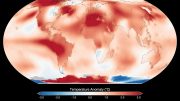

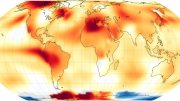
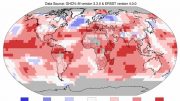

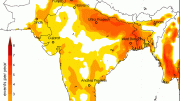


“In some regions, previous all-time record temperatures were exceeded by far, in other areas new daily or monthly records were recorded.”
It is obvious from the graphic supplied that there were some areas of the oceans that were cooler than usual, albeit not as widely spread. Why aren’t similar anomalies shown for the land areas?
It is unlikely that we actually know the average global temperature to a precision of +/-0.005 deg C because of sampling issues. The error bars (uncertainty envelope) are not provided, so we also don’t know if the differences are statistically significant. Why do the authors not speak to the issue of statistical significance of their reported numbers? They imply that they know temperatures exactly, which is not the case. Who are they trying to fool? Themselves, the readers, or both?
Why is there no color scale provided to allow the reader to determine the actual anomaly temperatures? Why are Antarctica anomalies not shown, or are the blue colors undefined, colder than average anomalies? Earlier in July, there was a predicted hot spot in Antarctica that led to the prediction of the hottest July 4th on record, which NOAA disavowed. See the map at: https://scitechdaily.com/feeling-the-burn-july-2023-was-the-hottest-month-on-record/ .
I feel that we are getting cherry picked data.